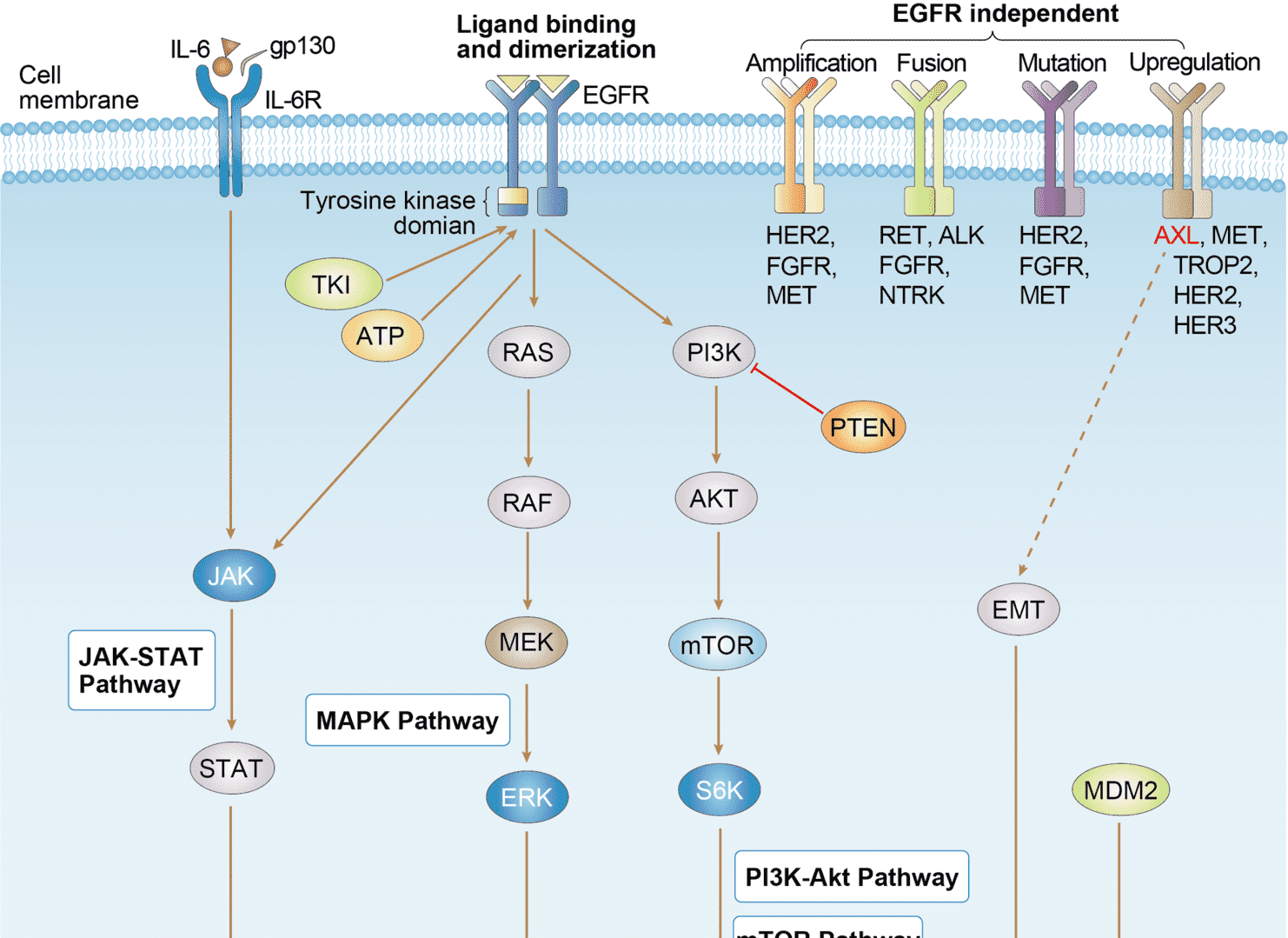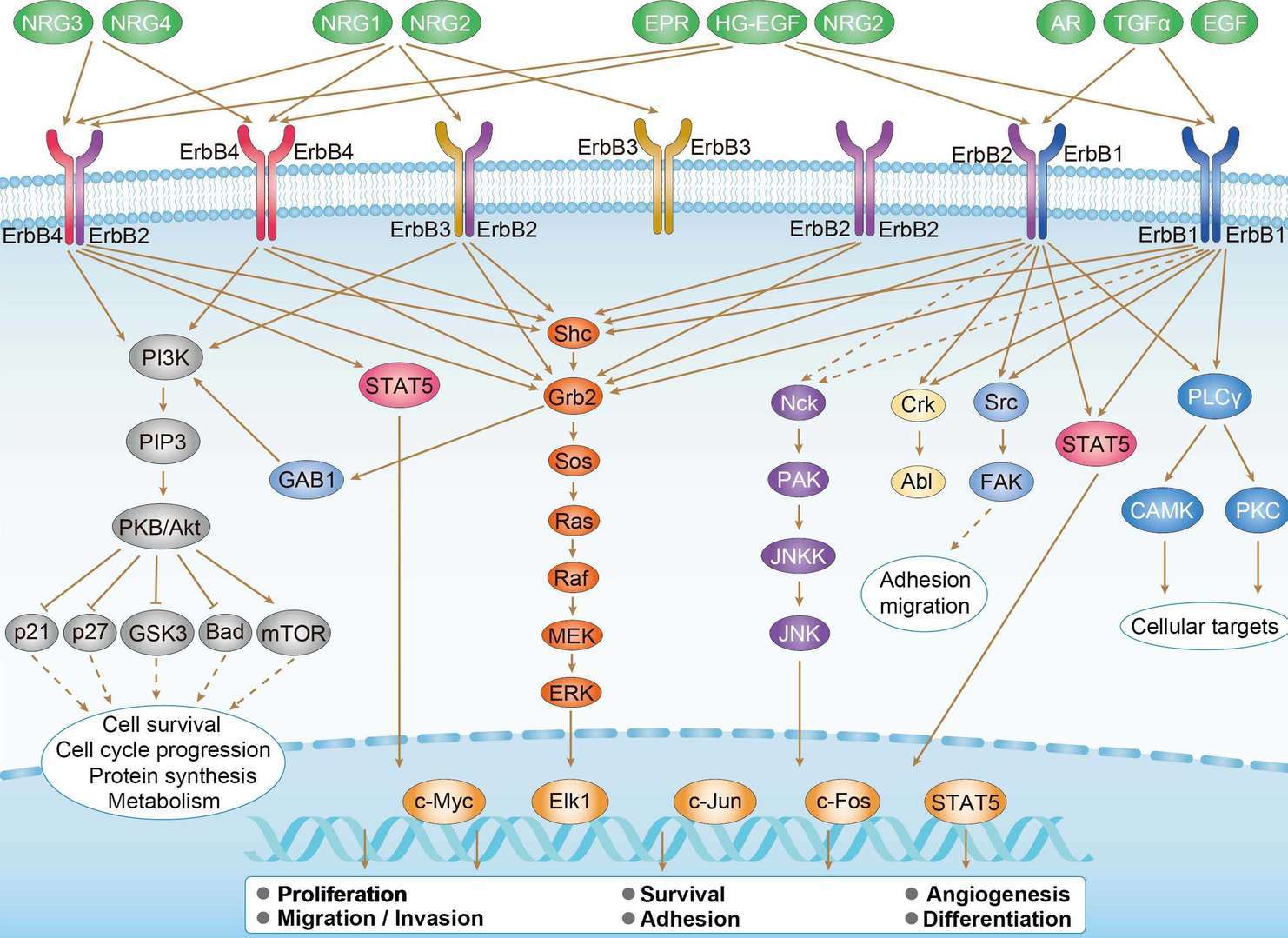Afuco™ Anti-Human ERBB3 ADCC Recombinant Antibody (LJM716), ADCC Enhanced
CAT#: AFC-232CL
Anti-ERBB3 ADCC Enhanced Antibody (LJM716) is an ADCC enhanced antibody produced by our Afuco™ platform. LJM716 is an anti-HER3 antibody that inhibits both HER2 and NRG driven tumor growth by trapping HER3 in the inactive conformation.














Specifications
- Host Species
- Human
- Derivation
- Human
- Type
- ADCC enhanced antibody
- Species Reactivity
- Human
- Related Disease
- Breast Cancer
Product Property
- Purity
- >95% as determined by Analysis by RP-HPLC & analysis by SDS-PAGE
- Storage
- ≤6 months at 4°C; ≥6 months at -20°C.
Target
- Alternative Names
- ERBB3; erb-b2 receptor tyrosine kinase 3; HER3; LCCS2; ErbB-3; c-erbB3; erbB3-S; MDA-BF-1; c-erbB-3; p180-ErbB3; p45-sErbB3; p85-sErbB3; receptor tyrosine-protein kinase erbB-3; proto-oncogene-like protein c-ErbB-3; human epidermal growth factor receptor 3; tyrosine kinase-type cell surface receptor HER3; v-erb-b2 avian erythroblastic leukemia viral oncogene homolog 3
- Gene ID
- 2065
- UniProt ID
- P21860
Customer Review
There are currently no Customer reviews or questions for AFC-232CL. Click the button above to contact us or submit your feedback about this product.
Submit Your Publication
Published with our product? Submit your paper and receive a 10% discount on your next order! Share your research to earn exclusive rewards.
Related Diseases
Related Signaling Pathways
Downloadable Resources
Download resources about recombinant antibody development and antibody engineering to boost your research.
Product Notes
This is a product of Creative Biolabs' Hi-Affi™ recombinant antibody portfolio, which has several benefits including:
• Increased sensitivity
• Confirmed specificity
• High repeatability
• Excellent batch-to-batch consistency
• Sustainable supply
• Animal-free production
See more details about Hi-Affi™ recombinant antibody benefits.
Datasheet
MSDS
COA
Certificate of Analysis LookupTo download a Certificate of Analysis, please enter a lot number in the search box below. Note: Certificate of Analysis not available for kit components.
See other products for "ERBB3"
Select a product category from the dropdown menu below to view related products.
| CAT | Product Name | Application | Type |
|---|---|---|---|
| NAB-1729-sdAb | Recombinant Anti-human ERBB3 VHH Single Domain Antibody | WB, ICC, ChiP, FA, ELISA | Llama VHH |
| TAB-070CT | Llama Anti-ERBB3 Recombinant Single Domain Antibody (TAB-070CT) | FC, Block | Llama VHH |
| PABC-556 | Recombinant Llama Anti-ERBB3 Single Domain Antibody (PABC-556) | ELISA, SPR | Llama VHH |
| CAT | Product Name | Application | Type |
|---|---|---|---|
| MOB-1319z | Mouse Anti-ERBB3 Recombinant Antibody (clone 22C5) | ELISA, ICC, IF, WB | Mouse IgG1 |
| TAB-H47 | Humanized Anti-Human ERBB3 Recombinant Antibody (TAB-H47) | ELISA, Inhib | Human IgG1, κ |
| PABL-086 | Human Anti-ERBB3 Recombinant Antibody (clone KTN3379) | ELISA, WB, IF, FuncS | Human IgG |
| PABL-127 | Human Anti-ERBB3 Recombinant Antibody (PABL-127) | ELISA, WB, FuncS | Human IgG |
| PABL-128 | Mouse Anti-ERBB3 Recombinant Antibody (PABL-128) | WB, Block, FuncS | Mouse IgG |
| CAT | Product Name | Application | Type |
|---|---|---|---|
| TAB-189 | Human Anti-ERBB3 Recombinant Antibody (TAB-189) | IP, IF, FuncS, FC, Neut, ELISA, ICC | Human IgG1, κ |
| TAB-H21 | Anti-Human ERBB3 Recombinant Antibody (TAB-H21) | FC, IP, ELISA, Neut, FuncS, IF, WB | Human IgG |
| TAB-244CL | Anti-Human ERBB3 Recombinant Antibody (TAB-244CL) | WB, ELISA | Antibody |
| TAB-0033CL | Human Anti-ERBB3 Recombinant Antibody (TAB-0033CL) | ELISA, FuncS, Inhib, FC | Human IgG |
| TAB-0034CL | Human Anti-ERBB3 Recombinant Antibody (TAB-0034CL) | ELISA, FuncS, Inhib, FC | Human IgG |
| CAT | Product Name | Application | Type |
|---|---|---|---|
| TAB-892 | Anti-Human ERBB3/ErbB 3 Recombinant Antibody (Seribantumab) | IF, IP, Neut, FuncS, ELISA, FC, ICC | IgG2 - lambda |
| TAB-H22 | Anti-Human ERBB3 Recombinant Antibody (Duligotuzumab) (TAB-H22) | ELISA, IP, FC, FuncS, Neut, IF, ICC | IgG1 - kappa |
| TAB-057CT | Human Anti-ERBB3 Recombinant Antibody (TAB-057CT) | Inhibion, ELISA | Humanized antibody |
| TAB-058CT | Human Anti-ERBB3 Recombinant Antibody (TAB-058CT) | ELISA, Inhib, Cty, IHC, WB, FC | Human IgG1, κ |
| TAB-059CT | Anti-Human HER3 Recombinant Antibody (LMAb3) | WB, ELISA, Inhibition, FC | Humanized antibody |
| CAT | Product Name | Application | Type |
|---|---|---|---|
| AGTO-L074E | HRGβ2-PE immunotoxin | Cytotoxicity assay, Functional assay |
| CAT | Product Name | Application | Type |
|---|---|---|---|
| PSBL-086 | Human Anti-ERBB3 Recombinant Antibody (clone KTN3379); scFv Fragment | ELISA, WB, IF, FuncS | Human scFv |
| PSBL-127 | Human Anti-ERBB3 Recombinant Antibody; scFv Fragment (PSBL-127) | ELISA, WB, FuncS | Human scFv |
| PSBL-128 | Mouse Anti-ERBB3 Recombinant Antibody; scFv Fragment (PSBL-128) | WB, Block, FuncS | Mouse scFv |
| HPAB-0286-YC-S(P) | Mouse Anti-ERBB3 Recombinant Antibody (clone 1153); scFv Fragment | ELISA, FuncS, FC | Mouse scFv |
| HPAB-0287-YC-S(P) | Mouse Anti-ERBB3 Recombinant Antibody (clone 920104); scFv Fragment | ELISA, FuncS, FC | Mouse scFv |
| CAT | Product Name | Application | Type |
|---|---|---|---|
| PFBL-086 | Human Anti-ERBB3 Recombinant Antibody (clone KTN3379); Fab Fragment | ELISA, WB, IF, FuncS | Human Fab |
| PFBL-127 | Human Anti-ERBB3 Recombinant Antibody; Fab Fragment (PFBL-127) | ELISA, WB, FuncS | Human Fab |
| PFBL-128 | Mouse Anti-ERBB3 Recombinant Antibody; Fab Fragment (PFBL-128) | WB, Block, FuncS | Mouse Fab |
| HPAB-0286-YC-F(E) | Mouse Anti-ERBB3 Recombinant Antibody (clone 1153); Fab Fragment | ELISA, FuncS, FC | Mouse Fab |
| HPAB-0287-YC-F(E) | Mouse Anti-ERBB3 Recombinant Antibody (clone 920104); Fab Fragment | ELISA, FuncS, FC | Mouse Fab |
| CAT | Product Name | Application | Type |
|---|---|---|---|
| TAB-0508CL | Anti-Human ERBB3 Recombinant Antibody (1A5) | ELISA, FC, Inhib, FuncS | |
| TAB-0509CL | Anti-Human ERBB3 Recombinant Antibody (3D4) | Inhib, FC | |
| TAB-0552CL | Mouse Anti-ERBB3 Recombinant Antibody (TAB-0552CL) | ELISA, Inhib | Mouse IgG |
| TAB-0553CL | Mouse Anti-ERBB3 Recombinant Antibody (TAB-0553CL) | ELISA, Inhib | Mouse IgG |
| TAB-0508CL-S(P) | Anti-Human ERBB3 Recombinant Antibody scFv Fragment (1A5) | ELISA, Inhib, FuncS |
| CAT | Product Name | Application | Type |
|---|---|---|---|
| TAB-061CT | Human Anti-ERBB3 Recombinant Antibody (TAB-061CT) | Inhib, ELISA | Chimeric (Rabbit/Human) antibody |
| TAB-061CT-S(P) | Human Anti-ERBB3 Recombinant Antibody; scFv Fragment (TAB-061CT-S(P)) | Inhib, ELISA | Human scFv |
| TAB-061CT-F(E) | Human Anti-ERBB3 Recombinant Antibody; Fab Fragment (TAB-061CT-F(E)) | Inhib, ELISA | Chimeric (Rabbit/Human) Fab |
| CAT | Product Name | Application | Type |
|---|---|---|---|
| NEUT-738CQ | Mouse Anti-ERBB3 Recombinant Antibody (clone CBL932) | Neut, IP | Mouse IgG1 |
| NEUT-739CQ | Mouse Anti-ERBB3 Recombinant Antibody (clone CBL483) | FC, CyTOF®, ELISA, Neut | Mouse IgG1 |
| NEUT-740CQ | Human Anti-ERBB3 Recombinant Antibody (clone CBL1019) | Neut | Human IgG1, κ |
| NEUT-741CQ | Human Anti-ERBB3 Recombinant Antibody (clone CBL1020) | Neut | Human IgG1, κ |
| NEUT-742CQ | Mouse Anti-ERBB3 Recombinant Antibody (NEUT-742CQ) | Neut | Mouse IgG1 |
| CAT | Product Name | Application | Type |
|---|---|---|---|
| MOR-1179 | Hi-Affi™ Rabbit Anti-ERBB3 Recombinant Antibody (clone DS1179AB) | ICC, IF, WB | Rabbit IgG |
| CAT | Product Name | Application | Type |
|---|---|---|---|
| AFC-TAB-H21 | Afuco™ Anti-ERBB3 ADCC Recombinant Antibody, ADCC Enhanced (AFC-TAB-H21) | FC, IP, ELISA, Neut, FuncS, IF | ADCC enhanced antibody |
| AFC-TAB-422CQ | Afuco™ Anti-ERBB3 ADCC Recombinant Antibody, ADCC Enhanced (AFC-TAB-422CQ) | ELISA, IHC, FC, IP, IF, BL | ADCC enhanced antibody |
| AFC-TAB-189 | Afuco™ Anti-ERBB3 Recombinant Antibody (AFC-TAB-189), ADCC Enhanced | IP, IF, FuncS, FC, Neut, ELISA | Human IgG1, κ |
| AFC-TAB-H22 | Afuco™ Anti-ERBB3 ADCC Recombinant Antibody, ADCC Enhanced (AFC-TAB-H22) | ELISA, IP, FC, FuncS, Neut, IF | ADCC enhanced antibody |
| AFC-TAB-892 | Afuco™ Anti-ERBB3 ADCC Recombinant Antibody, ADCC Enhanced (AFC-TAB-892) | IF, IP, Neut, FuncS, ELISA, FC | ADCC enhanced antibody |
| CAT | Product Name | Application | Type |
|---|---|---|---|
| VS-0424-XY92 | AbPlus™ Anti-ERBB3 Magnetic Beads (Duligotuzumab) | IP, Protein Purification | |
| VS-0724-YC1400 | AbPlus™ Anti-ERBB3 Magnetic Beads (VS-0724-YC1400) | IP, Protein Purification |
| CAT | Product Name | Application | Type |
|---|---|---|---|
| VS-0125-FY22 | Human Anti-ERBB3 (clone H3) scFv-Fc Chimera | ELISA, Inhib | Human IgG1, scFv-Fc |
| VS-0125-FY23 | Human Anti-ERBB3 (clone PM6) scFv-Fc Chimera | WB, ELISA, IHC, FuncS, BI | Human IgG1, scFv-Fc |
| CAT | Product Name | Application | Type |
|---|---|---|---|
| VS-0425-YC478 | Recombinant Anti-ERBB3 Vesicular Antibody, EV Displayed (VS-0425-YC478) | ELISA, FC, Neut, Cell-uptake |
| CAT | Product Name | Application | Type |
|---|---|---|---|
| VS-0525-XY2337 | Anti-ERBB3 Immunohistochemistry Kit | IHC | |
| VS-0525-XY2338 | Anti-Mouse ERBB3 Immunohistochemistry Kit | IHC |
| CAT | Product Name | Application | Type |
|---|---|---|---|
| VS-0525-YC72 | Recombinant Anti-ERBB3 (Domain 1 x Domain 3) Biparatopic Antibody, Tandem scFv (Clone 1153 x Clone 920104) | ELISA, FC | Tandem scFv |
| VS-0525-YC74 | Recombinant Anti-ERBB3 (Domain 3 x Domain 4) Biparatopic Antibody, Tandem scFv (Clone 920104 x Clone 1126) | ELISA, FC | Tandem scFv |
| CAT | Product Name | Application | Type |
|---|---|---|---|
| VS-0825-YC118 | SmartAb™ Recombinant Anti-ERBB3 pH-dependent Antibody (Clone Seribantumab) | ELISA, FC, ICC, IF, IP, Neut | Human IgG2 lambda |
Popular Products

Application: ELISA, IP, FC, FuncS, Neut, IF, ICC

Application: ELISA, Neut, IF, IP, FC, FuncS

Application: IF, IP, Neut, FuncS, ELISA, FC, ICC

Application: ELISA

Application: ELISA, FC, Inhib

Application: Neut, ELISA, WB, SPR, IF, EM

Application: Neut, ELISA, IF, IP, FuncS, FC

Application: ELISA, FC
For research use only. Not intended for any clinical use. No products from Creative Biolabs may be resold, modified for resale or used to manufacture commercial products without prior written approval from Creative Biolabs.
This site is protected by reCAPTCHA and the Google Privacy Policy and Terms of Service apply.

















 EGFR Tyrosine Kinase Inhibitor Resistance
EGFR Tyrosine Kinase Inhibitor Resistance
 ErbB Signaling Pathway
ErbB Signaling Pathway
















